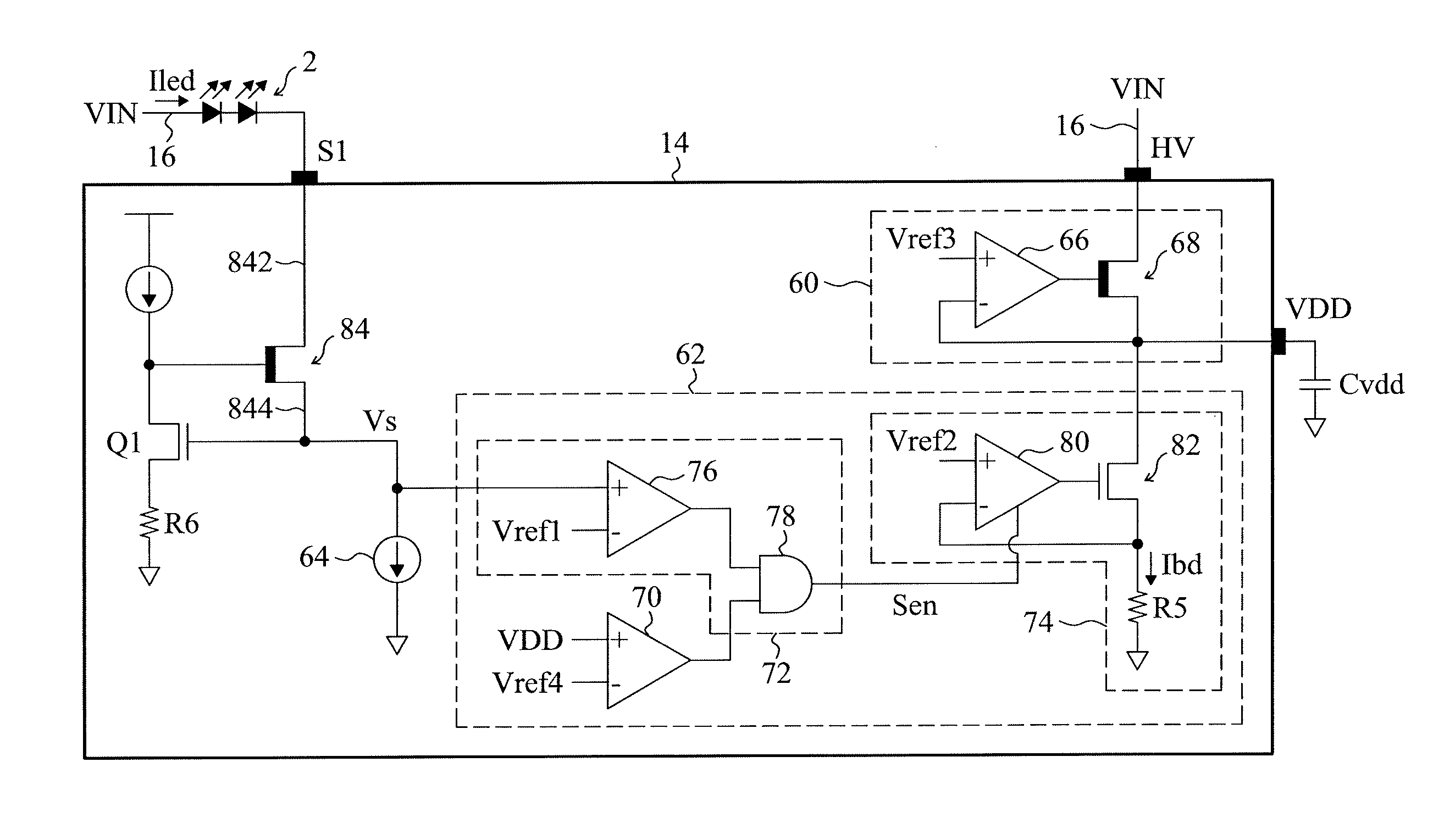Linear LED driver and control method thereof
a technology of led driver and led light, applied in the direction of electric variable regulation, process and machine control, instruments, etc., can solve the problems of bleeder circuits that need extra high-voltage components or pins, led flickering, and high cost, so as to prevent bleeder current, prevent led flickering, and prevent led flickering
- Summary
- Abstract
- Description
- Claims
- Application Information
AI Technical Summary
Benefits of technology
Problems solved by technology
Method used
Image
Examples
first embodiment
[0029]FIG. 6 shows the present invention. FIG. 6 only shows a control circuit in an IC 14. Other parts of the linear LED driver 10 can be referred to FIGS. 1 and 3. The IC 14 in FIG. 6 comprises a voltage regulator 60, a bleeder circuit 62, a current source 64 and a transistor 84. The transistor 84 includes an input terminal 842 coupled to an LED 2 via a pin S1. The switching of the transistor 84 controls the LED 2 to be lighted up or turned off. The transistor 84 adopts a high-voltage component such as the metal-oxide-semiconductor field effect transistor (MOSFET) or the insulated gate bipolar transistor (IGBT). The current source 64 is coupled to an output terminal 844 of the transistor 84 for regulating a current Iled that goes through the LED 2. The voltage regulator 60 is coupled to a voltage supply terminal 16 via a pin HV, thereby converting a driving voltage VIN into a power voltage VDD used by the linear LED driver 10. The voltage regulator 60 includes an operation amplifie...
third embodiment
[0034]FIG. 10 shows the present invention. Similar to that of FIG. 7, the circuit in FIG. 10 also comprises the transistors 84, 86, 88, and 90 for respectively controlling the LEDs 2, 4, 6, and 8, the voltage regulator 60 for converting the driving voltage VIN into the power voltage VDD, and the bleeder circuit 62 for providing the bleeder current. Differently, the detecting circuit 72 of the bleeder circuit 62 in FIG. 10 utilizes more than one comparators 102, 104, 106, and 108 to detect a voltage Vs1 of the output terminal 844 of the transistor 84, a voltage Vs2 of the output terminal 864 of the transistor 86, a voltage Vs3 of the output terminal 884 of the transistor 88, and a voltage Vs4 of the output terminal of the transistor 90, respectively. Moreover, the detecting circuit 72 in this embodiment also utilizes an OR gate 110 to handle the outputs of the comparators 102, 104, 106, and 108, thereby determining whether to enable the current source 74 to generate the bleeder curre...
fourth embodiment
[0035]FIG. 11 shows the present invention. The circuit of FIG. 11 is similar to that of FIG. 6. Differently, the bleeder circuit 62 in FIG. 11 is not coupled to the voltage supply terminal 16 via the voltage regulator 66 and the pin HV. The bleeder circuit 62 in this embodiment is directly coupled to the voltage supply terminal 16 via another pin BD. The bleeder circuit 62 directly bears the driving voltage VIN which is a high voltage, so the transistor 82 of the current source 74 in the bleeder circuit 62 has to adopt a high-voltage component. The operation of the circuit in FIG. 11 is also similar to that in FIG. 6. When the voltage Vs of the output terminal 844 of the transistor 84 is lower than the threshold Vref1, it is meaning that the LED 2 is turned off. At this time, the detecting circuit 72 generates an enable signal Sen to enable the current source 74 so as to generate the bleeder current Ibd to prevent the LED 2 from flickering. When the power voltage VDD is lower than t...
PUM
 Login to View More
Login to View More Abstract
Description
Claims
Application Information
 Login to View More
Login to View More - R&D
- Intellectual Property
- Life Sciences
- Materials
- Tech Scout
- Unparalleled Data Quality
- Higher Quality Content
- 60% Fewer Hallucinations
Browse by: Latest US Patents, China's latest patents, Technical Efficacy Thesaurus, Application Domain, Technology Topic, Popular Technical Reports.
© 2025 PatSnap. All rights reserved.Legal|Privacy policy|Modern Slavery Act Transparency Statement|Sitemap|About US| Contact US: help@patsnap.com



